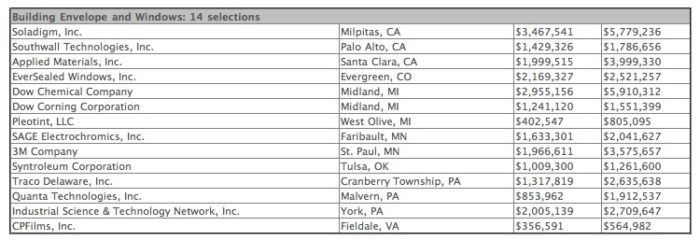
Image Credit: Department of Energy
Among the 58 energy efficiency research projects around the country recently granted $76 million in federal stimulus funds, the category getting the biggest share is “Building Envelope and Windows,” whose 14 projects are splitting $22,807,255.
Coming in a close second is “Advanced Building Control Strategies, Communications, and Information Technologies for Net-Zero Energy Buildings,” with 12 projects landing a $22,497,833 piece of the pie.
The other categories are “Residential and Commercial Heating, Ventilation, and Air Conditioning, and Crosscutting Air Conditioning and Refrigeration Research” (10 projects, $11,144,592 in federal funds); “Water Heating, Residential, and Commercial Appliances and Miscellaneous Electric Loads” (four projects, $6,033,246); and “Analysis, Design, and Technical Tools” (five projects, $5,969,682). All of the allocations were made by the Department of Energy and announced on Thursday, and almost all of the projects are aiming for innovation in various aspects of both commercial and residential building.
The research juggernaut
The DOE, of course, is by now an old hand at allocating funds to energy efficiency research and improvement projects, from the long-running Weatherization Assistance Program to Oak Ridge National Laboratory’s collaboration with the Zero Energy Building Research Alliance to the agency’s biennial Solar Decathlon competitions on Washington, DC’s National Mall.
This $76 million rollout, which also covers the development of training programs for commercial-building operators, sends money to several academic institutions (Cornell University, Syracuse University, University of California, among many others), big corporate players (including Dow Chemical Company, 3M Company, General Electric, and Whirlpool Corp.), and a few smaller entities (among them Pleotint LLC, Porticos Inc., and EverSealed Windows).
Getting innovation in the ground
Colorado-based EverSealed Windows, for example, received a $2,167,327 allocation, which, along with company funding, will bring $2,521,257 to bear on a project designed to demonstrate the feasibility of manufacturing and marketing vacuum insulating glass units for use in R-10 windows.
As a backdrop to its funding announcement this week, the DOE posted a video documenting the construction practices in Greensburg, Kansas, whose recovery after a tornado flattened the town in 2007 has made it a kind of laboratory for green building and the use of renewable energy. Whatever advances are derived from the research projects, the agency notes, “Greensburg has shown that any city can reach its energy efficiency and renewable energy goals today using widely available technologies.”
Weekly Newsletter
Get building science and energy efficiency advice, plus special offers, in your inbox.














0 Comments
Log in or create an account to post a comment.
Sign up Log in